This blog is provided by the IPR Center for Diversity, Equity, and Inclusion. It accompanies a podcast series called “The Future of PR Looks Like Us” exploring the diverse voices that have shaped the industry and featuring work done by PR students from Centennial College. This campaign was created in partnership with the Canadian Council of Public Relations Firms (CCPRF).
Why diversity?
The murder of George Floyd in May of 2020 sparked protests against systemic racism and support for the Black Lives Matter movement (#BLM) worldwide. Like many others, organizations and practitioners of PR were driven to speak out in support of change and racial justice for Black, Indigenous and other people of colour (BIPOC) (Ghane, 2020). Organizations are also discovering diversity “can bring fresh perspectives, insights, wider range of skills, ideas and innovation” (Man, 2020). This critical issue leads us to reflect on the diverse people who have shaped our industry as we know it today.
Here are three Black PR Pioneers that revolutionized the field of public relations:
Joseph V. Baker
Joseph V. Baker was the first African American president of the Public Relations Society of America (PRSA) and the first African American to earn an accreditation in PR designation. He convinced companies to have Black representation in advertising and encouraged them to hire Black workers to create brand loyalty. Baker introduced the idea of representation to the profession and taught public relations professionals to use their voices to advocate for groups that need support. It takes one brave voice to spark meaningful change for future generations. As Jerome Kitenge says, “Without his courage and groundbreaking ideas, we wouldn’t have the Nike and H&M ads that prominently feature POC.”
Moss Kendrix
Moss Kendrix identified the Black consumer market that had previously gone unnoticed by companies like Coca-Cola. His campaigns’ successes helped the company grow in advertising and, on a larger scale, led to increased job and business opportunities for Black Americans. As Mikhail Grishin said in his profile of Kendrix, even when it was not considered fitting to speak about minorities, Moss knew there was a place in society for Black people to be represented and appreciated.
Inez Kaiser
Inez Kaiser was the first African American woman to open her own public relations firm and serve national clients. Her client accounts included Burger King Corporation, Southwestern Bell Telephone Company, and Sears Roebuck & Company. She played an active role in the NAACP and used her role as a communicator to spread effective messages during the civil rights movement. Her tenacity and perseverance paved the way for women in PR industry today.
Takeaways for the Profession
These Black pioneers left an everlasting impact on the industry. However, the responsibility no longer falls on BIPOC practitioners alone. Everyone is called to use their voices in advocacy and allyship to continue the legacy of the likes of Joseph Baker, Moss Kendrix, and Inez Kaiser. These Black communicators underscored the importance of honesty and integrity in their work. They were respected for their transparency and inclusive vision.
Society progresses, and behind that progression are powerful voices pushing advocacy work. Public relations should create and foster environments where this advocacy and activism can be supported and cultivated. When it comes to DE&I in the workplace, collaboration and listening will foster continuous growth, understanding and empathy.
Advocating for representation in workplaces and media engages employees and allows new consumer markets to feel seen, leading to business advantages. “Businesses with culturally diverse executive teams are 33% more likely to see above-average profits” (Lam, 2020) . Diversity means that unique individuals and groups are less likely to be disregarded. “Diversity is vital to the effectiveness and credibility of PR. It’s crucial to encourage more people of all races to pursue careers … and to create spaces where diverse practitioners feel safe, included and empowered to do their jobs effectively” (Carrington, 2020). If people feel represented, it builds trust in communicators and messages, making public relations work much more effective.
Your voice has power, and after unpacking today’s episode, we invite you to reflect on your position and perspective, and the changes you can make to advance DE&I in your life and community.
Resources
Heinrich, L.L. Black PR pioneers. The Museum of Public Relations. https://www.prmuseum.org/black-pr-pioneers
Carrington, S. (2020, September 13). Does PR have a diversity problem? Canadian Public Relations Society Toronto. https://cprstoronto.com/2020/09/13/does-pr-have-a-diversity-problem/
Ghane ,A. (2020). #BlackLivesMatter: An overview of the PR response. GenerationPR. https://generationpr.ca/black-lives-matter-public-relations/
Colston, C. E. (2012). An Exploration into the Reality of Media Perceptions: The Depictions of Women Public Relations Practitioners in Reality Television. McNair Scholars Research Journal, 5(1), 33-50.
| Hagerty, J. R. (2016, August 12). Inez Kaiser Broke Down Barriers for Minorities in Public Relations.
The Wall Street Journal. |
| Lam, L. (2020, November 7). The time-of-the-century opportunity that diversity and inclusion present to Canadian business. Focus Communications. https://focuscomms.com/insights/the-time-of-the-century-opportunity-that-diversity-and-inclusion- present-to-canadian-business/ |
Meade, J. (2020, June 05). Remembering The First Black Woman to Own a PR Firm. PR News. https://www.prnewsonline.com/Kaiser-PR-owner-black-woman
Pioneer spotlight: Moss Hyles Kendrix. The Museum of Public Relations. https://www.prmuseum.org/pioneer-moss-kendrix
Schmitt, W. (2016, August 4). Inez Y. Kaiser, first black woman to own a national PR firm, dies at 98. The Kansas City Star. https://www.kansascity.com/news/local/article93759187.html
Nestle, M. (2015, October 5). Soda Politics: Taking on Big Soda (and Winning). Oxford University Press. https://global.oup.com/academic/product/soda-politics-9780190263430
Taylor, M. (2011, February 19). A Salute to Public Relations’ African-American Pioneers https://apps.prsa.org/Intelligence/Tactics/Articles/view/9086/1026/A_Salute_to_Public_Relations_African_American_Pion#.X6CKQC_b00o
Sarah Heiman: Before Heiman started at Centennial College, she graduated from Western University with an honours degree in media in the public interest. She tailored her education to focus heavily on activism, learning about marginalized communities and anti-racism work. This passion led to her experience at non-profits organizations writing blog posts, assisting with fundraising events and social media.
Twitter: @SarahHeiman98
Daisy Johanna Uy: Uy has cultural acumen from her 10 years of corporate experience in Asia, North America, Europe, the Middle East and Oceania. She holds a B.Sc. in chemical engineering from the University of San Carlos, Philippines, and completed anti-racism and bias training with Brownicity, an American grassroots initiative. Twitter: @IAmDaisyU
Charmaine Blair: With years of corporate, business and hospitality management, Blair has worked and volunteered with not-for-profit organizations throughout her career, committed to supporting diversity and inclusion. A recent graduate of the special event planning program at Centennial College, she returned to complete her studies in public relations.
Twitter: @charblair2
Rebecca Moe: Moe holds a bachelor of social science from the University of Ottawa. Her background in outdoor recreation has allowed her to apply her passion for using policy, curated experiences and relationship management for building inclusive and safe spaces for people to experience growth.
Twitter: @moe_re_becca
Links to podcast: Link to podcast on Centennial College Webpage




